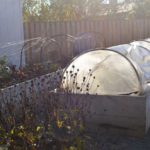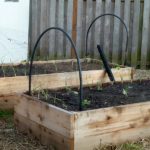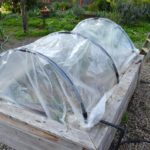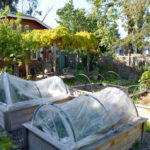Partly it is my own fault. I should have started seeds earlier. Partly it is related to Eugene. There is a later frost date here than in Portland, which I wasn’t expecting. And partly it is because I desperately want my students from the Urban Farm to see that “See, it really does work to grow stuff!”
I have taken matters into my own hands with row covers. The plants are getting plenty of water from Spring showers and the temperature is warm enough for them to be outside. But nothing but warm air and sunshine will get them going at this point. They will just shiver lightly outside, holding their own, until we finally get past the last frost date.
Screw that and bring on the plastic! Row covers went on earlier this week over a couple beds at the farm, holding things like lettuce, kale, broccoli, onions, cabbage, etc. The same white cloudy domes are being sported in my own backyard as well. It’s time to get serious here.
My experience has been that row covers set me ahead a whole month with planting. Things that can’t be planted out until May can actually go out in April with a good row cover. When my plants normally bush out in May, they look full in April instead.
It can be a great thing, but it requires a closer eye. You will need to water periodically as plants use the existing water in the domes. Tender young plants can’t handle a dry spell. You also need to remember to still check for signs of weeds and slugs. Just because they are out-of-sight doesn’t mean they can be out-of-mind.
When it comes to row cover plastic, the best option will be greenhouse plastic. It lasts several years, is very clear, but is very expensive. Emphasis on “very”. Alternatively, you can use contractor plastic sheeting, but be careful you dispose of it before it disintegrates. Depending on how many months it is left out in the sun, it will eventually dry out, crack and shatter all over the garden.
The farm can afford nice greenhouse plastic but I have to admit I use the cheap stuff at my place. Even the cheap stuff works well though, if you can prevent plastic bits ending up all over your garden. The forecast calls for sunshine this weekend, so along with the row covers the plants should get a’growing!









 I start with a
I start with a



 There's a go
There's a go
